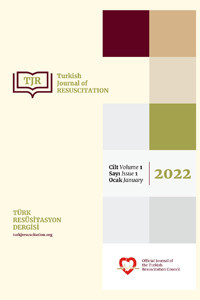RESÜSİTASYON SIRASINDA ULTRASONOGRAFİK MONİTÖRİZASYON
Erken tanı ve müdahale şansı sağlaması nedeni ile, hastane içi tanıklı kardiyak arrestlerde sağkalım oranı hastane dışı kardiyak arrestlerden daha yüksektir. Gerekli tıbbi cihazlara hızlı erişim geri döndürülebilir nedenlerin tanısının hızlıca gözden geçirilmesini ve bu nedenlere yönelik tedavilerin erken başlamasını sağlamaktadır.Son zamanlarda geri döndürülebilir nedenlerin araştırılmasında ultrasonografi kullanımının yeri sıklıkla vurgulanmaktadır.
Anahtar Kelimeler:
Resüsitasyon, eFAST, Monitörizasyon
ULTRASONOGRAPHIC MONITORIZATION DURING RESUSCITATION
In-hospital witnessed cardiac arrest leads to more successful outcomes than out-of-hospital cardiac arrests, as it provides the chance for early and effective intervention. The rapid and on-site use of the necessary equipment that can provide a quick review of reversible causes and early intervention of the reversible causes in the initial stages of resuscitation can provide a successful resuscitation opportunity. Recently, the effectiveness of ultrasonographic examinations has been stated and recommended in the detection of reversible causes.
Keywords:
Resuscitation, eFAST, Monitorization,
___
- Høybye M, Stankovic N, Holmberg M, Christensen H.C, Granfeldt A, Andersen LW. In-hospital vs. out-ofhospital cardiac arrest: patient characteristics and survival. Resuscitation, 2021;158: 157-165.
- Soar J, Böttiger B.W, Carli P, Couper K, Deakin C.D, Djarv T et al. European Resuscitation Council guidelines 2021: adult advanced life support. Resuscitation, 2021;161:115- 151.
- McLean, A. R, Richards M.E, Crandal C.S, Marinaro J et al. “Ultrasound determination of chest wall thickness: implications for needle thoracostomy.” The American journal of emergency medicine 2011; 29.9:1173-1177.
- Goodman A, Phillips P, Mailhot T, Mandavia D. “The role of bed-side ultrasound in the diagnosis of pericardial effusion and cardiac tamponade.” Journal of emergencies, trauma, and shock 2012; 5.1:72.
- Early access to defibrillation for cardiac arrest. Australasian College for Emergency Medicine. July 2020. URL: https://acem.org.au/getmedia/a2e8a4c1-2764-4096-a65d- 76383149f3b5/P40-Early-Access-to-Defibrillation-for- Cardiac-Arrest
- American Heart Association in Collaboration with the International Liaison Committee on Resuscitation. ECC Guidelines. Part 4: The Automated External Defibrillator. Key Link in the Chain of Survival. Circulation. 2018;102: I-60–I-76.
- Koster RW, Walker RG, Chapman FW. Recurrent ventricular fibrillation during advanced life support care of patients with prehospital cardiac arrest. Resuscitation 2008; 78:2527.
- Başlangıç: 2022
- Yayıncı: Resüsitasyon Derneği
Sayıdaki Diğer Makaleler
RESÜSİTASYON SIRASINDA ULTRASONOGRAFİK MONİTÖRİZASYON
Gözde GÜRSOY ÇİRKİNOĞLU, Mehmet Ersegün DEMİRBOĞA, İlknur KARAKUL ÖZMETE, Tayfun ADANIR
COVID-19 PANDEMİ DÖNEMİNDE MAVİ KODA GİDEN SAĞLIK EKİPLERİNİN KAYGI DÜZEYİNİN DEĞERLENDİRİLMESİ
Hazal KARAASLAN, Gönül TEZCAN KELEŞ, Artuner DEVECİ
HASTANEMİZDE PANDEMİ SÜRESİNCE ‘COVID-19 DIŞI’ MAVİ KOD UYGULAMALARIMIZIN DEĞERLENDİRİLMESİ
Aslı KARSLI KOÇ, Meltem KİPRİ, Ferhat ŞAMLI, Şule AKIN, Anış ARIBOĞAN
GEBEDE BEKLENMEYEN KARDİYAK ARREST VE HEDEFE YÖNELİK SICAKLIK YÖNETİMİ
